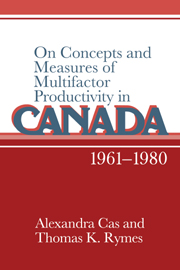Book contents
- Frontmatter
- Contents
- List of tables
- Acknowledgements
- Part I Introduction
- Part II Measures of multifactor productivity, Canada, 1961–1980: Introduction to the experimental estimates
- 4 Canadian input–output accounts and data base for MFP
- 5 Estimation of the rates of growth of MFP by industry
- 6 Multifactor productivity, measures of structural change, and the productivity of labour
- 7 Measures of multifactor productivity for the aggregate economy
- 8 Summary and conclusion
- Appendices
- Bibliography
- Name index
- Subject index
4 - Canadian input–output accounts and data base for MFP
Published online by Cambridge University Press: 11 September 2009
- Frontmatter
- Contents
- List of tables
- Acknowledgements
- Part I Introduction
- Part II Measures of multifactor productivity, Canada, 1961–1980: Introduction to the experimental estimates
- 4 Canadian input–output accounts and data base for MFP
- 5 Estimation of the rates of growth of MFP by industry
- 6 Multifactor productivity, measures of structural change, and the productivity of labour
- 7 Measures of multifactor productivity for the aggregate economy
- 8 Summary and conclusion
- Appendices
- Bibliography
- Name index
- Subject index
Summary
Introduction
The Canadian input–output tables provide the most complete detailed accounting of economic activity in Canada for the business, personal, and government sectors. These tables are fully integrated within the Canadian System of National Accounts. They provide a conceptual framework or structure within which are fitted and arranged data of economic activities that are both collected and statistically estimated. The input–output tables are an invaluable source of data, quite apart from their use in standard I/O analysis.
Unfortunately, the emphasis on these tables is on the flows of currently produced outputs and inputs in the economic activities of Canada. Consequently, the tables are very rich in the representation of current output flows through the economic system – as intermediate outputs or final demand outputs. They are very poor on their accounting of the flows of the services of primary inputs such as labour and capital. Only the payments to these factors of production appear as aggregate values in the tables. In the case of produced capital inputs, the tables neither establish the relationship between stocks and flows nor calculate the yearly changes in the stocks of capital coming from the investment or capital formation flows that they record.
Thus, there is abundant information on the commodity outputs of industries and their interindustry flows in the industry production accounts of the I/O tables that are of interest to this study. This is contained in matrices with 191 industries and 595 commodities.
- Type
- Chapter
- Information
- Publisher: Cambridge University PressPrint publication year: 1991



